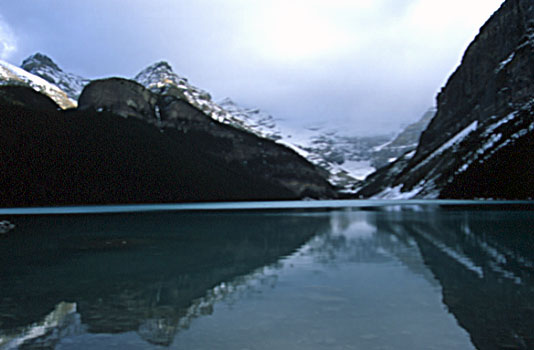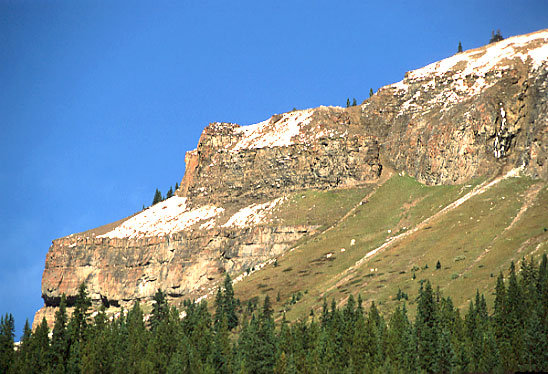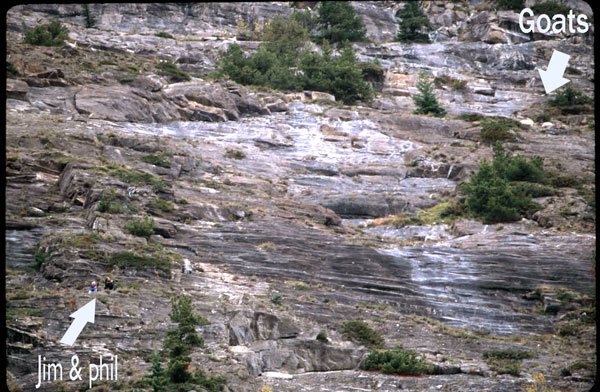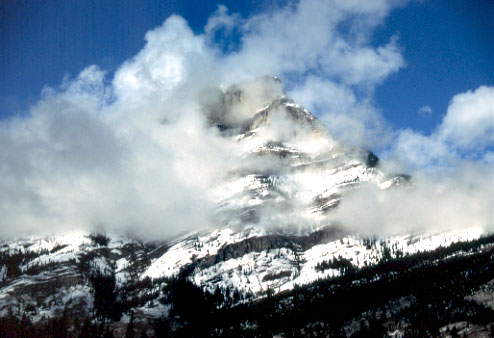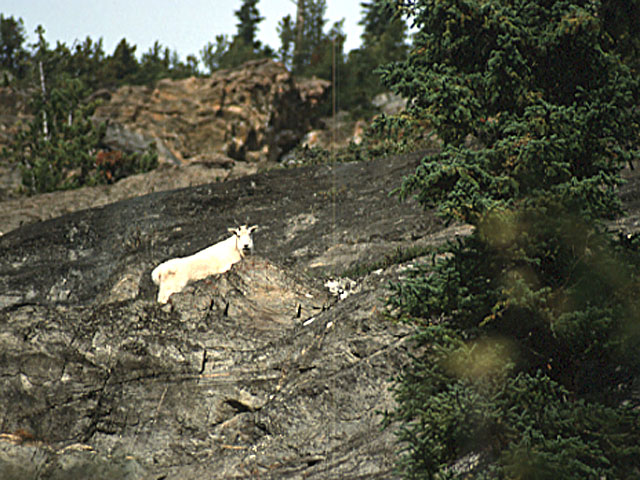|
The Lure of HIGH ADVENTURE
With Jim Moerschel
I was first introduced to Phil Maranda a few years ago when we were both photographing and writing articles for Nature Photographer Magazine. I wrote to Phil and we developed our friendship and decided to share a few photo adventures
together.
So here we were driving the scenic back roads of The Canadian Rockies in Jasper National Park. It was the first week of October, a great time for us to be here. The Aspen trees were at their golden yellow peak, mountain tops were snow covered and best of all, the elk, sheep and goats were down out of their high summer range within the range of our long lenses. It was a photographers dream come true. Phil, as I was about to find out is one of the finest "extreme sports" photographers in North America. His high adventure exploits have been published
in several adventure magazines worldwide and he was about to take me on one of
them.
We spotted several white dots on a cliff face and stopped our car. Not too high up was a family group of mountain goats – a prized photographic trophy. We didn’t hesitate. We knew we had to do a bit of climbing so we each selected one camera body, one lens and placed them into a small camera bag slung over a shoulder and grabbed our tripods. We were off. The first obstacle was the boulder field at the base of the cliff and after several zig zagging runs we made it to the base of the cliff. It looked awfully steep to me, but Phil urged me on. So up we went. Phil has grown up in these mountains and has lived most of his life here, so climbing is second nature to him, but not to an easterner like me. But, when there is a photograph to be had, especially of a hard to get cagey animal like a mountain goat, my adrenaline overcomes everything and pushes me to the limits. So, as Phil started up the switchback ledges I was flushed with the excitement of the chase and hot on his heels. Up we went. The switchback ledges were fairly wide at first, but narrowed to about 2 – 3 feet as we climbed higher. The goats by this time were on the move as they knew we were after them. We could see them up above. Scant views, nothing we could photograph just yet, but that yearning feeling that we would get a great shot
drove us higher and higher up that cliff.
This is why I have photographed nature for the past 30 years or so. It is so unpredictable, adventuresome, exciting and creative – all at the same time. The feeling is intoxicating and addictive. Nature photographers develop a sense of "seeing" the final image in their minds eye and I had the image of one of those goats already "imbedded" on a frame of 100 ISO Provia film even though we still were out of range. Up we climbed and the goats moved higher, always "just" out of range. The ledges were getting narrower too. Some were 18 inches in spots and just when we were about to agree that we shouldn’t go any higher, the
goats would give us a teasing glimpse – luring us higher.
Finally, we both looked down and Phil’s red SUV looked about the size of a grape - a very small, red grape. Phil mentioned that we were getting an eagles view of this magnificent valley. It was spectacular, but we were after goats and we still were out of photographic range. We were getting closer though. We saw their fresh dung piles, now steaming in the frigid mountain air on the very ledges we were traversing. Suddenly, a goat appeared just above us. For a brief moment he stared down, watching us traverse his domain – then vanished as if a vapor in the wind. Luckily, the ledge we were now on was about 5 feet wide. We could finally set up tripods and we did. Out came the cameras. Mine was my Nikon N90s and my 400mm telephoto, which was quickly snapped onto a ball-head aimed skyward and we were set. Both of us huddled into the cliff face out of sight of the nearest goat. We didn’t have to wait long. The inquisitive goat reappeared, trying to see where these invaders were. Our lenses were aimed right at him, but he was only partially visible – still not a good shot. Anticipating the "moment of truth" I rechecked my camera settings. I shoot in aperture priority mode, which gives me control over "depth of field." I set the f stop to f8 to give me reasonable depth on my image, the camera will then select the shutter speed. I’m not concerned about that since I’m using a rock steady tripod. The camera is also set for auto focus and the
meter is on matrix metering. All that is needed is a visible goat.
Then it happened - Suddenly. The goat moved out onto an exposed ledge to gain a better view of us and froze like a statue in my viewfinder. He must have been pretty high up, because even with 400mm he was still not full frame. But it was still a nice image and after all that climbing I wasn’t about to lose this prize. As I depressed the shutter, I could "feel" the auto focus "lock in" on the goat. He was mine. The shutter clicked 6 times like a semi automatic rifle. Again the goat vanished, but Phil and I had captured the brief moment and now it was time to pack up and climb down from our 500 foot perch – our high adventure at an end. Our friend, Sal Calabrese had stayed far below concentrating on landscape photos, while Phil and I made the climb. The photo of the cliff with two faint dots on the face was created by Sal using a 100 – 400 mm focal length lens from the edge of the boulder field. I wish you good luck in your image making and may all your visions be photogenic.
|
